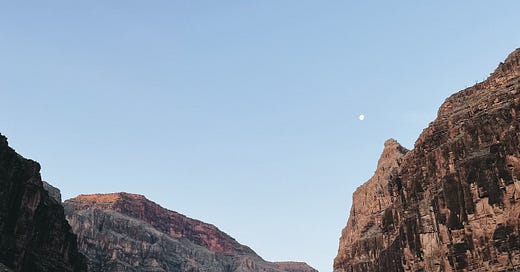I recently returned to “normal life” after spending two weeks in the bottom of the Grand Canyon. For two weeks I woke up at sunrise, rafted the rapids of the Colorado River, hiked the hidden side canyons and crevices, and slept under the stars. There were no phones or streetlights or advertisements, only the towering red walls of the canyon, the thundering green water of the Colorado.
When I arrived at put-in, the starting point of the river trip, I had this idea that my ecology degree would somehow elevate me as a visitor of the Grand Canyon.
I understood the complex water rights battle in the West. I knew that desert plants use a different photosynthetic pathway to maximize water retention. I would have a unique perspective on the ecology of the Grand Canyon because I studied ecology in my “regular” life.
But there is a vast difference between studying ecology in school and experiencing the ecology of a place.
I can tell you about the nitrogen cycle and ecosystem recovery and predator-prey dynamics, but I didn’t even know the names of the invasive species in the Grand Canyon. I didn’t know that desert rivers are supposed to accumulate silt and sand, turning the water red with mud. I didn’t even realize the Grand Canyon had a history of volcanism until we floated past old lava flows.
“It’s important for scientists to come on these trips,” one of the guides remarked. “The ecology is out here.”
I was momentarily defensive (because didn’t my master’s degree prepare me to be a knowledgeable and responsible ecologist???), but he was right.
Studying ecology in academia is important and necessary for conducting scientific research and interpreting observations. But learning ecology by being outside is the only way to really experience those ecosystem processes.
If we think of studying ecology only as reading journal articles and attending lectures and performing lab work, we lose our connection to the land. We lose our connection to the actual ecology.
And let’s not forget that hitting the books is the newest way to learn about nature. People have been learning from the land and from each other for thousands of years – Indigenous people have more ecological knowledge than any university department.
It became clear to me on this trip that learning requires being. It was not enough to hear a fact about the ecosystem and retain it, I had to allow myself to be a part of the ecosystem. I had to witness the invasive tamarisk choking the banks of the Colorado River. I had to reach out and touch the smooth, black lava rocks. I had to get slapped in the face by a wave of freezing cold river water, turned cloudy by the desert silt it was carrying from a recent flash flood.
I was humbled, and a little bit embarrassed, by how much I didn’t know, but I was also mesmerized by how much there was to learn. The more time I spent in the canyon, the more I could study its ecology by simply existing and observing.
When I returned home, my life and my approach to studying ecology no longer felt “normal.” It was one way to learn about the world, but it wasn’t the way to learn about the world. It was learning without being.
Of course I’ll keep reading journal articles and analyzing my data and participating in ecology as an academic field. But I’ll also remember every time I venture out into nature, whether it’s the monumental rock walls of the Grand Canyon or the scraggly live oaks of my hometown, “the ecology is out here.”




Love this!!